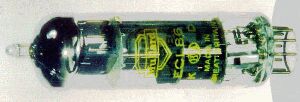|
http://www.ozvalveamps.org/valvecodes.html | Created: 24/09/05 | Last update:
12:31 18/10/06
<<< OzValveAmps |

Working out who made it, and when.
by Chris Arthur
I have to say this straight out... Date Codes are a real prick to decipher!!!
You would know through your dealings with vintage electronics that a reasonable standard for date codes really only began to appear in the early 70's. Prior to this it was pretty well manufacturer dependant and basically obscure!
The following description is applicable to Mullard and Philips vacuum tubes, it may also apply to other manufacturers but only by coincidence.
Generally (and I can't express that enough) a Mullard or Philips vacuum tube will be marked near the base with a 2 row code, the first row is the manufacturers type code and the second row is a country/date code.
Mullard in Australia also used a straight 3 digit number code that was a 2 digit year code with the month being last - YYM - but this was not a generally used code.
Note: The following applies to Mullard & Philips tubes made after 1956, prior to this the manufacturers used a change code. Sorry but I little info on these pre 56 codes:
XX - Manufacturers own tube code, This can can be three characters (XXX) as well.
FYM - Factory (or Country code), Year (last digit), Month (A=Jan, B=Feb...)In 1961 Mullard and Philips added a week code 1, 2, 3, 4 & 5.
XXX - Manufacturers own tube code (post 1961)
FYMW - Factory (or Country code), Year (last digit), Month (A=Jan, B=Feb...), Week (1, 2, 3, 4 & 5)The obvious problem with the year code is that it repeats every 10 years but you can loosely say that a 3 character date code would have most likely manufactured prior to 1961 (56 - 61).
For example:
I grabbed an old Mullard tube from our recycled spares, it's an EL34, made in great Britain. A faint 2 row code (yellow/green in colour) can be found just above the base, it reads as follows...First row - X f 2
2nd row - B 8 C 4I'll ignore the first row because that's a manufacturers code but the second row supplies me with the following information:
B = Blackburn, England (see lookup table attached)
8 = Would be 1968 (A week code dates this tube post 1961)
C = The month of March
4 = Fourth week of MarchOK so we now know that this tube was manufactured at Blackburn, England in the 4th week of March 1968.
The Australian made Mullard tubes generally have a date code starting with a “C”.
By the early 70's most of the old vacuum tube companies had ceased tube production or sold off shore.
The old codes were pretty well ditched and the actual year/batch was then printed on the tubes.
Hope this helps a little!
ChrisManufacturer codes list 1 (76kb GIF), list 2 (50kb GIF).
New: 13:34 18/10/06
Found on: UncleSpot
Mullard EL34 production codes
This was a post on an amp BBS asking about Mullard EL34 production codes, what they mean, and my esponse:
I know this has been discussed here before, but I've misplaced my hard copy of how to decipher this. I have several NOS Mullard EL34's, dark choc. brown bases. Etched codes are as follows:
: xf2 B9H2
: xf1 B1E2
: xf1 B1F4
: xf2 B0L2
: xf2 B2D3xf1 coding indicates Mullards made in the Blackburn Works, in the U.K., from the late '50s to the early '60s.
xf2 indicates either the Blackburn Works in the U.K., or Eindhoven, Holland tube factory (after Philips Electronics bought Mullard in the '60s). The differences in the 2 facilitie's tubes are in the bases - color and size, and the getters. Both facilities made these tubes for other companies (for rebranding) as well.
In the case of the 1st letter, ie 'B' for xf2 that's the factory code, xf1=Blackburn, xf2=Blackburn -or- Eindhoven, Holland.
The 9 would be 1969 (in the xf2 case). The 'H' is the date code month -August. (A = Jan, B = Feb,... H = Aug), and the '2' is another date code, the week. In this case the 2nd week of August.
In the 'xf1' case the 'B' is Blackburn, the '1' is 1961, the 'E' is May, and '2' is the 2nd week of May. etc for the other tubes...
This is information I've rcv'd/learned from Vacuum Tube Valley magazine, and also from working for Philips Electronics - Electron Optics Division (based in Eindhoven, Holland) from 1984 - 1998. -Ron
|
|